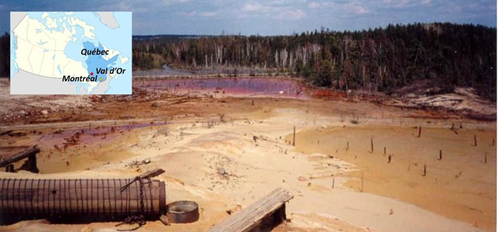Adapting to the changing climate requires a long-term vision. However, at present, most climate projections stop at 2100, offering nothing to sectors with infrastructure requiring them to anticipate changes in climate hazards over the very long term.
This is the context in which an exploratory project led by Ouranos, in collaboration with the Université du Québec en Abitibi-Témiscamingue (UQAT), was initiated. It aims to develop climate scenarios going beyond 2100 to support the adaptation of mining infrastructure.
A key application for the mining industry
One of the mining industry’s main climate change vulnerabilities is mine closure sites. When mining ends, permanent structures are built to restore the land and to limit potential ecological impacts, such as acid mine drainage.
What is acid mine drainage?
Acid mine drainage occurs when mine tailings generate acidity upon contact with air and water, leading to an increase in metal contaminants in the nearby environment.
This can have potentially disastrous consequences for nearby ecosystems and communities.

Photograph of the Manitou mine site near Val-d’Or, Quebec, contaminated by acid mine drainage (from: Dimech, 2018).
Although various types of mine site reclamation facilities are used, their constant exposure to weather conditions requires design that takes long-term projections into account. This is crucial and helps limit the risks associated with climate-related hazards. Factors such as increased rainfall or more frequent droughts must be integrated into mine closure management strategies to prevent the degradation and pollution of former mine sites.
As part of this project, different post-2100 climate scenarios will be produced to help mine site managers anticipate climate change and adapt their infrastructure to future climate conditions. Three case studies will be conducted to demonstrate the utility of these scenarios. The project’s results will be useful in other situations requiring long-term planning, such as energy supply and coastal zone management.
Learn more about the research project Post-2100 Climate Scenarios - Case Studies in the Mining Sector:
The challenges of post-2100 data production
Most climate scenarios stop at 2100 due to the difficulty of producing reliable data beyond that horizon. The technical and scientific obstacles are considerable, such as:
The reliability of projections: The further we go in time, the more uncertainty increases. Climate models describe the Earth’s response to greenhouse gas (GHG) scenarios, but it’s difficult to project what the GHG concentrations will be in 200 or 300 years or more. They depend on human society’s efforts to reduce emissions and the effectiveness of carbon sinks.
The availability of climate scenarios: Most climate simulations stop in 2100. Only certain simulations extend to 2300— mainly those concerning very low emission scenarios (SSP1-2.6) and very high emission scenarios (SSP5.8-5). There is currently a lack of intermediate climate scenarios providing a more nuanced array of data.
Costs and resources: Each additional year of climate simulation involves enormous computing and data storage costs.
More distant climate projections thanks to CMIP7
The seventh phase of the CMIP climate simulation experimental protocol (ScenarioMIP-CMIP7) suggests that simulations extend at least until 2150. It also proposes that emissions scenarios be developed up to 2500, in particular to study the slow processes linked to climate change. It is therefore expected that, within a few years, the scientific community will have much more data for studying climate change beyond 2100.
That means the exploratory project by Ouranos and UQAT is in line with the aim of the international scientific community: to produce very long-term climate data to better anticipate and adapt to climate change.